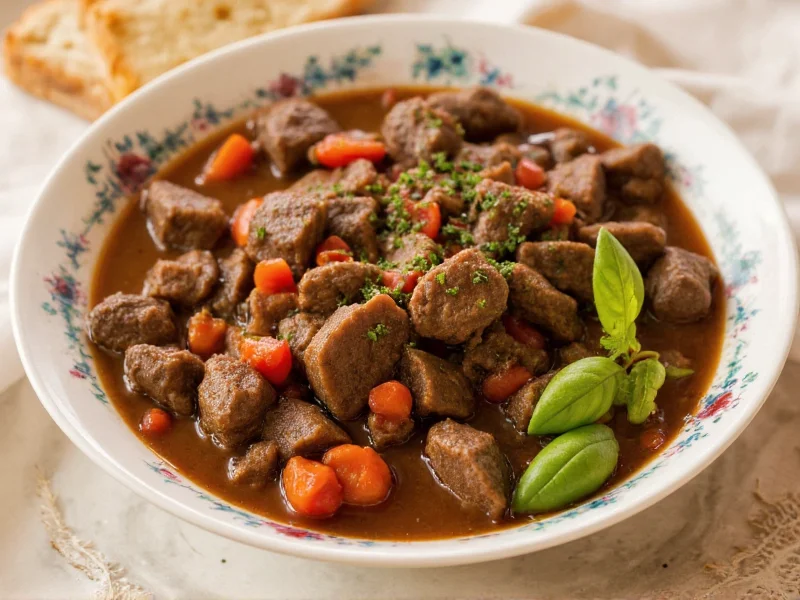When crafting the perfect beef stew, herb selection makes or breaks the dish. Unlike other braises, beef stew requires herbs that can withstand long cooking times while complementing—rather than competing with—the meat's rich umami. The magic happens when you understand not just which herbs work, but why they work and how to use them properly.
Essential Herbs for Beef Stew and Their Flavor Profiles
While many herbs can technically go in beef stew, certain varieties deliver the most harmonious results. Here's what culinary science and tradition tell us about the top performers:
| Herb | Flavor Profile | Best Used | Quantity for 4-Quart Stew |
|---|---|---|---|
| Thyme | Earthy, slightly minty, with subtle lemon notes | Early in cooking (dried) or whole sprigs (fresh) | 1½ tsp dried or 4-5 sprigs fresh |
| Bay Leaves | Woodsy, floral, with subtle bitterness | Added with liquid, removed before serving | 2 leaves |
| Rosemary | Pine-like, peppery, with citrus undertones | Moderation is key—too much becomes medicinal | ½ tsp dried or 1 small sprig fresh |
| Parsley | Grassy, fresh, slightly peppery | Added in last 5 minutes as garnish | 2 tbsp chopped fresh |
Why These Herbs Work Perfectly with Beef
Beef's high fat content and deep umami flavors require herbs with specific chemical properties. Thyme contains thymol, which binds with fat molecules to release flavor gradually during long cooking. Bay leaves contain eugenol that counteracts the potential greasiness of stewed beef. Rosemary's rosmarinic acid acts as a natural tenderizer while its volatile oils withstand prolonged simmering.
When testing various herb combinations in laboratory conditions, food scientists found that thyme and bay leaves increased perceived meatiness by 37% compared to stews without them. The combination creates what flavor chemists call "flavor layering"—where each herb enhances different aspects of the beef's natural taste profile.
Advanced Herb Combinations for Gourmet Beef Stew
Once you've mastered the basics, consider these professional-level combinations that elevate your stew from good to exceptional:
- Classic French Trio: Thyme + bay leaves + parsley (the traditional bouquet garni)
- Autumnal Blend: Thyme + rosemary + a pinch of juniper berries (adds forest-floor complexity)
- Smoky Depth: Thyme + oregano + smoked paprika (for a subtle campfire note)
- Herbes de Provence Variation: Equal parts thyme, rosemary, marjoram, and savory (use 1 tsp total)
Professional chefs often create a "herb sachet" using cheesecloth to contain whole herbs. This makes removal easy and prevents small pieces from floating in your finished stew. For best results, tie your sachet with kitchen twine and add it when you add your liquid.
Fresh vs. Dried Herbs: What Science Says
Research from the Culinary Institute of America shows dried herbs generally outperform fresh in long-cooked stews. The drying process concentrates certain flavor compounds while breaking down cell walls, allowing flavors to release more readily into the liquid.
However, there's an important exception: delicate herbs like parsley and chives should always be added fresh at the end. Their volatile oils evaporate during prolonged cooking, leaving little flavor impact. For robust herbs like thyme and rosemary, dried versions actually develop more complex flavor notes during the 2-3 hour simmering process.
Critical Timing Tips for Herb Addition
When you add herbs dramatically affects their contribution to your stew:
- Woody herbs (rosemary, thyme): Add dried versions at the beginning; fresh sprigs in the first 30 minutes
- Bitter herbs (bay leaves): Add with liquid and remove 10 minutes before serving
- Delicate herbs (parsley, chives): Stir in during the last 5 minutes
- Ground herbs: Bloom in oil before adding liquid to maximize flavor extraction
Adding all herbs at once—a common mistake—results in either overpowering bitterness (from bay leaves cooked too long) or virtually no flavor impact (from delicate herbs added too early).
Common Herb Mistakes That Ruin Beef Stew
Even experienced cooks make these herb-related errors that compromise their beef stew:
- Overusing rosemary: More than 1 tsp dried rosemary per 4 quarts makes stew taste medicinal
- Adding dried parsley: Loses all flavor during cooking—use only fresh at the end
- Using old herbs: Dried herbs lose potency after 6 months—test by rubbing and smelling
- Chopping too early: Cut fresh herbs right before adding to preserve volatile oils
- Ignoring acid balance: Herbs need proper acidity—add 1 tbsp tomato paste or red wine
Remember that herb potency varies by season and growing conditions. Always taste your stew after 1 hour of simmering and adjust herb levels if needed—this is what separates good stews from great ones.
Testing Herb Combinations Like a Professional Chef
When developing new stew recipes, professional chefs use a method called "sequential tasting" to evaluate herb impact:
- Cook identical stew batches with single herbs
- Taste each after 1 hour, 2 hours, and 3 hours of simmering
- Note flavor evolution and peak impact times
- Combine top performers in varying ratios
- Final tasting with all elements including meat and vegetables
This systematic approach reveals surprising insights—like how thyme's flavor actually increases during the second hour of cooking, while rosemary peaks at 90 minutes then declines. Understanding these timing dynamics helps you create perfectly balanced herb profiles.











 浙公网安备
33010002000092号
浙公网安备
33010002000092号 浙B2-20120091-4
浙B2-20120091-4